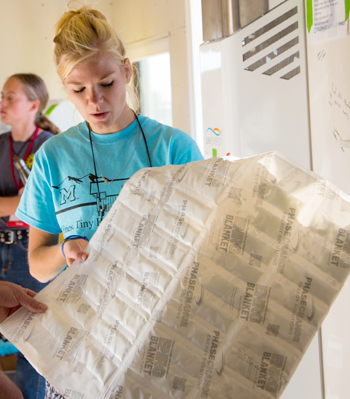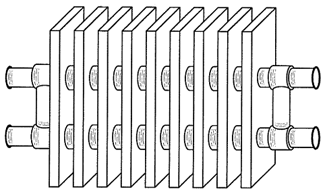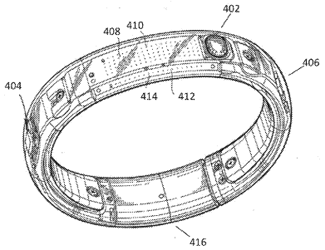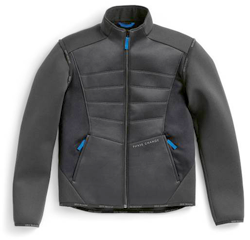 The Phase Change Matters e-mail newsletter is a weekly summary of the latest news and research on phase change materials and thermal energy storage. To subscribe, visit www.puretemp.com/subscribe. For more frequent updates, follow @puretemp on Twitter or visit the Phase Change Matters blog, www.puretemp.com/pcmatters.
The Phase Change Matters e-mail newsletter is a weekly summary of the latest news and research on phase change materials and thermal energy storage. To subscribe, visit www.puretemp.com/subscribe. For more frequent updates, follow @puretemp on Twitter or visit the Phase Change Matters blog, www.puretemp.com/pcmatters.
BUILDING | CONSTRUCTION
PCM mats will be put to the test in Colorado ‘tiny house’
The effectiveness of bio-based phase change material is being tested in a 200-square-foot “tiny house” under construction at the Colorado School of Mines in Golden, Colo.
 Katie Schneider, a junior majoring in engineering physics, is chairing the two-year student project, which is scheduled for completion in May 2018.
Katie Schneider, a junior majoring in engineering physics, is chairing the two-year student project, which is scheduled for completion in May 2018.
Though its interior is incomplete, the Mines Tiny House was exhibited at last month’s team Solar Decathlon in Denver. Schneider said the project attracted interest from representatives of the energy and sustainability industry, as well as from other schools that might want to partner with the School of Mines for the next Solar Decathlon in 2020.
“It was a great experience for us to interact with others interested in what we’re doing,” Schneider said, “and we got plenty of good ideas from the competitors as well.”
Entries in the Solar Decathlon, sponsored by the U.S. Department of Energy, are judged on energy efficiency, design, affordability and consumer appeal.
The University of Nevada-Las Vegas, one of 11 teams in this year’s decathlon, used a PCM product in the ceiling of its entry, a 990-square-foot home that won first place in the innovation category. Ecole Polytechnique of Lausanne, Switzerland, was the overall winner.
The School of Mines team is installing ENRG Blankets donated by Phase Change Energy Solutions of Asheboro, N.C. The multi-layer polymer mats, shown above, contain plant-based PCM with a melt-freeze transition temperature of 23º C (73º F). The mats are designed to absorb, store and release energy to help keep living spaces at comfortable temperatures and reduce energy costs.
“We plan to put the PCMs in the ceiling first, between the insulation and our ceiling paneling,” Schneider said. “We want to take temperature measurements with and without the PCMs to really test their effectiveness. Then we will possibly put them in the walls, especially near the wheel wells of the trailer because that is a vulnerable point of heat loss for the tiny house.”
COMPANY NEWS
Trane acquires CALMAC, maker of ice-based energy storage systems
Trane Inc. has acquired CALMAC Corp., a New Jersey company that specializes in ice-based energy storage systems.
CALMAC systems create and store ice when energy demand is low and then use the ice to cool buildings during periods of peak demand. The systems are integrated with Trane commercial HVAC systems. CALMAC systems help cool more than more than 4,500 buildings worldwide, including the corporate headquarters of JC Penney, Marriott and Google.
“CALMAC is pleased to be part of Trane,” said Mark MacCracken, chief executive officer of the privately held CALMAC. “We know that with the support and investments from Trane and its parent, Ingersoll Rand, CALMAC can expand the availability and distribution of our products, serving new and existing customers with the energy storage and ice solutions they demand.”
PATENTS
Forced air thermal energy storage system
U.S. patent application 20170321912 (applicant Viking Cold Solutions Inc., Houston, Texas):
 “A system including a chilled air generation system, a forced air convection system, one or more phase change material (PCM) modules, and a controller. The controller is configured to regulate the temperature of a facility by selectively utilizing the chilled air generation system and the forced air convection system based on multiple factors, which may include energy source type(s), relative costs of the energy from the source(s), availability of energy from the source(s), facility temperature, PCM module temperature, and/or temperature of goods stored within the facility, among other considerations. The controller may thus advantageously and cost-effectively control the periods of time during which the chilled air generation system is used and those during which the thermal energy stored in the PCM modules is used.”
“A system including a chilled air generation system, a forced air convection system, one or more phase change material (PCM) modules, and a controller. The controller is configured to regulate the temperature of a facility by selectively utilizing the chilled air generation system and the forced air convection system based on multiple factors, which may include energy source type(s), relative costs of the energy from the source(s), availability of energy from the source(s), facility temperature, PCM module temperature, and/or temperature of goods stored within the facility, among other considerations. The controller may thus advantageously and cost-effectively control the periods of time during which the chilled air generation system is used and those during which the thermal energy stored in the PCM modules is used.”
Dishwasher drying system with thermal storage heat exchanger
U.S. patent application 20170319045 (applicant Samsung Electronics Co. Ltd., Suwon-si, Republic of Korea):
“A dishwasher drying system includes an air inlet configured to receive hot, humid air from a tub of a dishwasher. The dishwasher drying system also includes an air outlet configured to discharge the air to an ambient environment outside the dishwasher. The dishwasher drying system further includes an air moving device configured to cause the air to move from the air inlet to the air outlet. In addition, the dishwasher drying system includes a thermal storage heat exchanger positioned within an airflow path of the moving air, the thermal storage heat exchanger configured to absorb heat and condense moisture from the moving air as the moving air contacts the thermal storage heat exchanger during a dishwasher drying cycle. … The thermal storage heat exchanger can include a phase change material (PCM), a non-PCM, or both.”
Athletic activity monitoring device
U.S. patent application 20170324018 (applicant Nike Inc., Beaverton, Ore.):
 “Aspects relate to an energy harvesting device adapted for use by an athlete while exercising. The device may utilize a mass of phase-change material to store heat energy, the stored heat energy subsequently converted into electrical energy by one or more thermoelectric generator modules. The energy harvesting device may be integrated into an item of clothing, and such that the mass of phase change material may store heat energy as the item of clothing is laundered.”
“Aspects relate to an energy harvesting device adapted for use by an athlete while exercising. The device may utilize a mass of phase-change material to store heat energy, the stored heat energy subsequently converted into electrical energy by one or more thermoelectric generator modules. The energy harvesting device may be integrated into an item of clothing, and such that the mass of phase change material may store heat energy as the item of clothing is laundered.”
IN BRIEF
• Registration is open for PCM 2018, the 12th IIR Conference on Phase Change Materials and Slurries for Refrigeration and Air Conditioning. The conference will be held May 21-23, 2018, in Orford, Québec. Topics will include thermal energy storage; thermophysical and rheological properties of PCMs and slurries; and transport phenomena and time-dependent behavior of PCMs and slurries.
• MIT researchers have developed a new way to mix oil and water and create an emulsion that remains stable for long periods — no shaking required.
• Registration is open for “Towards a Sustainable Solution to Melt Snow and Ice on Concrete Pavement: Use of Phase Change Materials, a presentation by Dr. Yaghoob Farnam, an assistant professor in the Department of Civil, Architectural and Environmental Engineering at Drexel University. Farnam will discuss his research on the use of PCM-enhanced concrete to inhibit the buildup of snow and ice on pavement. The program will be held Nov. 30 in King of Prussia, Penn.
• “Innovative Thoughts” blogger Harvey Wade visited the 3M Customer Innovation Centre in Bracknell, U.K., last month to find out how the big company sustains its innovative edge. Lesson No. 1: 3M listens to its customers. “They don’t guess what the customer needs,” Wade writes, “they invest their time to know their needs, discovering the big problems that they can try to solve.”
 • BMW‘s 2018 Motorrad collection includes the latest version of the PCM Ride jacket, featuring microencapsulated phase change material that “adapts permanently and smartly to the current temperature.”
• BMW‘s 2018 Motorrad collection includes the latest version of the PCM Ride jacket, featuring microencapsulated phase change material that “adapts permanently and smartly to the current temperature.”
• Peli BioThermal has opened a service center in Brussels, Belgium, to handle its Credo line of reusable temperature-controlled packaging.
• Ember Technologies‘ newest temperature-control product, a $79 ceramic mug with an active heating system, contains no phase change material. The company’s first product, a PCM-lined travel tumbler, sells for $150.
• Grace Hsia, founder and CEO of Warmilu, a Michigan startup that makes an infant warming blanket, talks about the stresses and rewards of building a company from scratch. “I find my body will sometimes crash,” Hsia told Crain’s Detroit Business, explaining how 90-hour workweeks have led to bouts of pneumonia and bronchitis. “I’ve been trying to get more sleep, which is tough.”
• The preliminary program has been released for the fifth Building Enclosure Science & Technology conference, known as BEST5. It will take place April 15-18 in Philadelphia.
• The American Chemical Society has won its lawsuit against Sci-Hub, a widely used pirate site for scientific papers that was established in 2011 by former neuroscientist Alexandra Elbakyan.
• New from Intellectual Research Partners: “Global Thermal Energy Storage (TES) systems Market By Technology (Molten salt, Phase change materials, Water based, Electric thermal and Solar) End User Application (Air Conditioning, Cold Storage, Power Storage, Process Cooling) Region (North America, Europe, APAC) Forecast To 2023“
RESEARCH ROUNDUP
For our full list of recent academic research, see puretemp.com/academic. Here are highlights from the past week:
From Applied Energy:• Optimal design of PCM thermal storage tank and its application for winter available open-air swimming pool
From Solar Energy Materials and Solar Cells:
• Preparation of phase change material emulsions with good stability and little supercooling by using a mixed polymeric emulsifier for thermal energy storage
• Organic-inorganic hybrid shell microencapsulated phase change materials prepared from SiO2/TiC-stabilized pickering emulsion polymerization
From Solar Energy:
• An alternative approach for assessing the benefit of phase change materials in solar domestic hot water systems
From Energy Conversion and Management:
• An experimental investigation of discharge/solidification cycle of paraffin in novel shell and tube with longitudinal fins based latent heat storage system
From Energy:
• Thermal performance analysis of a cascaded cold storage unit using multiple PCMs
From Energy Procedia:
• Evolution of global heat transfer coefficient on PCM energy storage cycles
NETWORKING
Connect with PCM experts and industry leaders on LinkedIn
More than a thousand of your peers have joined a LinkedIn group devoted to the discussion of phase change material and thermal energy storage. The Phase Change Matters group is an interactive complement to the award-winning blog and newsletter of the same name.
 You are invited to join the group and connect with PCM and TES experts from around the world. New members include Babak Attari, design engineer at Rheem Manufacturing, Montgomery, Ala.; Andrea Frazzica, researcher at CNR-ITAE, Messina, Italy; Zakariaa Refaa, postdoctoral researcher at Empa, Dübendorf, Switzerland; Marcel van Beek, research engineer at Re/genT, Eindhoven, Netherlands; and Shreyas Srivastava, associate application engineer, Pluss Advanced Technologies, Gurgaon, India. Swanand Bhagwat, who joined a few months ago, writes:
You are invited to join the group and connect with PCM and TES experts from around the world. New members include Babak Attari, design engineer at Rheem Manufacturing, Montgomery, Ala.; Andrea Frazzica, researcher at CNR-ITAE, Messina, Italy; Zakariaa Refaa, postdoctoral researcher at Empa, Dübendorf, Switzerland; Marcel van Beek, research engineer at Re/genT, Eindhoven, Netherlands; and Shreyas Srivastava, associate application engineer, Pluss Advanced Technologies, Gurgaon, India. Swanand Bhagwat, who joined a few months ago, writes:
“I am currently working as a postdoc at Drexel University and working on design and development of a rotary heat exchanger (HX) with encapsulated phase change materials (EPCM). This technology is primarily being developed for dry cooling of power plants and also has a potential application in cooling of data centers.
“The HX is fabricated out of PCM (paraffin wax) embedded in a multi-chambered flattened tube made of HDPE. The EPCM structure is continuously rotating at a small speed and acts as a short term thermal energy storage system. For proof of concept, we have constructed a 3 kWth prototype and are in a process of testing it for optimization of design parameters.
“If you are interested, please take a look at my profile page to know more about the working concept and videos.”